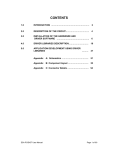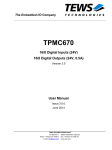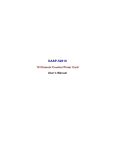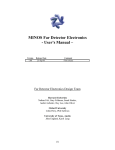Download PCI8282 User`s Manual
Transcript
DASP-52048 48 Channel DI/O and 1 Timer/Counter Card User’s Manual Disclaimers The information in this manual has been carefully checked and is believed to be accurate. Axiomtek Co., Ltd. assumes no responsibility for any infringements of patents or other rights of third parties which may result from its use. Axiomtek assumes no responsibility for any inaccuracies that may be contained in this document. Axiomtek makes no commitment to update or to keep current the information contained in this manual. Axiomtek reserves the right to make improvements to this document and/or product at any time and without notice. No part of this document may be reproduced, stored in a retrieval system, or transmitted, in any form or by any means, electronic, mechanical, photocopying, recording, or otherwise, without the prior written permission of Axiomtek Co., Ltd. ©Copyright 2004 by Axiomtek Co., Ltd. All rights reserved. September 2004, Version A1.0 Printed in Taiwan ii ESD Precautions Integrated circuits on computer boards are sensitive to static electricity. To avoid damaging chips from electrostatic discharge, observe the following precautions: Do not remove boards or integrated circuits from their anti-static packaging until you are ready to install them. Before handling a board or integrated circuit, touch an unpainted portion of the system unit chassis for a few seconds. This helps to discharge any static electricity on your body. Wear a wrist-grounding strap, available from most electronic component stores, when handling boards and components. Trademarks Acknowledgments AXIOMTEK is a trademark of Axiomtek Co., Ltd. IBM is a registered trademark of International Business Machines Corporation. MS-DOS, and Windows 95/98/NT/2000 are trademarks of Microsoft Corporation. Phoenix-Award is a trademark of Phoenix-Award Software, Inc. IBM, PC/AT, PS/2, VGA are trademarks of International Business Machines Corporation. Intel and Celeron, Pentium III are trademarks of Intel Corporation. Other brand names and trademarks are the properties and registered brands of their respective owners. iii Table of Contents Chapter 1 Introduction.....................................................1 1.1 1.2 1.3 Features ...................................................................2 Specifications..........................................................3 Accessories .............................................................4 Chapter 2 2.1 2.2 Hardware Installation ...................................5 Board Layout ...........................................................5 Signal Connections.................................................6 2.2.1 Signal Connection Descriptions ............................ 6 2.2.2 Digital Input/Output Connector CON1 ................. 7 2.3 DI/DO Circuits and Wiring ....................................11 2.3.1 2.3.2 2.3.3 2.3.4 2.3.5 2.4 Quick Setup and Test ...........................................15 Chapter 3 3.1 Emulate 8255 I/O Port........................................... 11 Interrupt Function.................................................. 12 Digital Input Port Circuits and Wiring................... 13 Digital Output Port Circuits and Wiring................ 14 Jumper Settings..................................................... 14 Registry Structure and Format...................19 Overview ................................................................19 3.1.1 Read/Write 8255 Chip0 Input/Output Port A, B and C (Base Address + Offset 0x00-02) ................................. 19 3.1.2 Write 8255 Chip 0 Control Word (Base Address + Offset 0x03) ....................................................................... 20 3.1.3 Read/Write 8255 Chip1 Input/Output Port A, B and C (Base Address + Offset 0x04-06) ................................. 20 3.1.4 Write 8255 Chip 1 Control Word (Base Address + Offset 0x07) ....................................................................... 20 3.1.5 Write Soft Interrupt Trigger (Base Address + Offset 0x08).................................................................................. 21 3.1.6 Write Clear Interrupt (Base Address + Offset 0x09) ........................................................................................... 21 3.1.7 Write Clock and Interrupt Source Selection (Base Address + Offset 0x0A) .................................................... 21 iv 3.1.8 Read Device Label (Base Address + Offset 0x0B)22 3.1.9 Read/Write 82c54 Counter 0 – 2 (Base Address + Offset 0x0C-0E)................................................................. 22 3.1.10 Write 82c54 Counter Control Word (Base Address + Offset 0x0F) .................................................................... 22 Appendix A Dimension of DASP-52048 and Accessories ..........................................................................23 v This page does not contain any information. vi DASP-52048 Card User’s Manual C h a p t e r 1 Introduction The DASP-52048 is a PCI-bus, 48 TTL digital I/O and one timer/counter card. The DASP-52048 has a higher output current driving capability, allowing it to drive relay or LED elements. The DASP-52048 consists of six 8-bit bi-directional ports and two input lines for interrupt function, with each port allowing users to configure it as inputs or outputs. Board Identification- Serial Number on EEPROM The DASP stores the serial number of each DASP in the EEPROM before shipping. The PCI scan utility can scan all the DASP and show users the serial number of each DASP, helping the user to easily identify and access each card during hardware configuration and software programming. Introduction 1 DASP-52048 Card User’s Manual 1.1 Features 48 digital I/O lines Higher driving capability than 8255 Output read back status One 16-bit programmable event counter One 32-bit programmable timer Software programmable interrupt handling Software programmable clock source Windows® 98/NT/2000/XP and Labview 6.0/7.0 driver Supported Complete sample program- VB, VC, BCB, Delphi PCI Scan utility supported 2 Introduction DASP-52048 Card User’s Manual 1.2 Specifications Digital Inputs Type: TTL level Input voltage: High level 2.0V to 5.2V Low level -0.5V to 0.8V Load current: -0.45mA to +70(A) Digital Outputs Type: TTL level Sink Current: 0.4V@+64mA (Logic level 0) Source current: 2.4@-15mA (Logic level 1) Timer/Counter Frequency: 0 ~ 10 MHz Operation mode: One 16-bit event counter One 32-bit programmable timer Interrupt Number: 2 interrupt source Operation mode: software programmable General Environment I/O connector: 68-pin SCSI-II pin type female Power consumption: +5V @ 900mA (max.) Operating temperature: 0 ~ 60°C Storage temperature: -20 ~ 70°C Humility: 0 ~ 90% non-condensing Dimensions: 185mm x 122 mm Introduction 3 DASP-52048 Card User’s Manual 1.3 Accessories To make the DASP-52048 functionality complete, we carry a versatility of accessories for different user’s requirements in the following items: Wiring Cable CB-89268-2: 68-pin SCSI-II pin type male with 2m length CB-89268-5: 68-pin SCSI-II pin type male with 5m length CB-89468-2: 68-Pin SCSI-II (CENTRNIC) to 3-20 Flat 2M Cable CB-89468-5: 68-Pin SCSI-II (CENTRNIC) to 3-20 Flat 5M Cable Terminal Block TB-88268: 68-pin SCSI-II terminal block with DIN-rail mounting TB-88320: 20-Pin Header Box Male Wiring Terminal Board for DIN-Rail Mounting The terminal block is directly connected to I/O connector CON1 of the DASP-52048. Daughter Board DB-87822: 16-Channel Isolated D/I Board DB-87825: 16-Channel Relay Output Board 4 Introduction DASP-52048 Card User’s Manual C h a p t e r 2 Hardware Installation 2.1 Board Layout Board layout for DASP-52048 Hardware Installation 5 DASP-52048 Card User’s Manual 2.2 Signal Connections 2.2.1 Signal Connection Descriptions Signal Connections for DASP-52048 CON1: The I/O connector CON1 on the DASP-52048 is a 68-pin SCSI-II pin type connector for digital input/output signals. CON1 enables you to connect to accessories, such as the terminal block TB-88268, with the shielded 68-pin SCSI-II pin type cable CB-89268-2 or CB-89268-5. Another type of accessories, include terminal box with 20-pin header box male connector (TB-88320) and daughter board provides relay out (DB-87825) or photo isolation input (DB-87822) are also provided for signal wiring. A 68-pin SCSI-II (CENTRNIC) to 3-20 flat cable is used associated with these accessories. 6 Hardware Installation DASP-52048 Card User’s Manual 2.2.2 Digital Input/Output Connector CON1 DIO signal connections for DASP-52048 with TB-88268 CON1 CB-89268 TB-88268 Hardware Installation 7 DASP-52048 Card User’s Manual DIO signal connections for DASP-52048 with TB-88320 CON1 CB-89268 TB-88320 8 Hardware Installation DASP-52048 Card User’s Manual DIO signal connections for DASP-52048 with DB-87822 and DB-87825 CON1 CB-89268 DB-87822 Hardware Installation DB-87825 9 DASP-52048 Card User’s Manual The pin assignment of CON1 of DASP-52048 is listed as follows. Pin 1 2 3 4 5 6 7 8 9 10 11 12 13 14 15 16 17 18 19 20 21 22 23 24 25 26 27 28 29 30 31 32 33 34 10 Description Ch0 PA D0 Ch0 PA D1 Ch0 PA D2 Ch0 PA D3 Ch0 PA D4 Ch0 PA D5 Ch0 PA D6 Ch0 PA D7 GND +5V Ch0 PC D0 Ch0 PC D1 Ch0 PC D2 Ch0 PC D3 Ch0 PC D4 Ch0 PC D5 Ch0 PC D6 Ch0 PC D7 GND +5V Ch1 PA D0 Ch1 PA D1 Ch1 PA D2 Ch1 PA D3 Ch1 PA D4 Ch1 PA D5 Ch1 PA D6 Ch1 PA D7 GND +5V OSC 4M Hz 82c54 Out0 GND +5V Pin 35 36 37 38 39 40 41 42 43 44 45 46 47 48 49 50 51 52 53 54 55 56 57 58 59 60 61 62 63 64 65 66 67 68 Description Ch0 PB D0 Ch0 PB D1 Ch0 PB D2 Ch0 PB D3 Ch0 PB D4 Ch0 PB D5 Ch0 PB D6 Ch0 PB D7 GND +5V Ch1 PC D0 Ch1 PC D1 Ch1 PC D2 Ch1 PC D3 Ch1 PC D4 Ch1 PC D5 Ch1 PC D6 Ch1 PC D7 GND +5V Ch1 PB D0 Ch1 PB D1 Ch1 PB D2 Ch1 PB D3 Ch1 PB D4 Ch1 PB D5 Ch1 PB D6 Ch1 PB D7 GND +5V PCB_CLK 82c54 Out2 GND +12V Hardware Installation DASP-52048 Card User’s Manual 2.3 DI/DO Circuits and Wiring The TTL digital input and digital output wiring diagrams and functional block diagrams of DASP-52048 are depicted as following figure. The port A and port B of each channel can be configured as input or output ports. The upper nibble or lower nibble of port C can be configured as input or output separately. 2.3.1 Emulate 8255 I/O Port The DASP-52048 emulates 2 channels 8255 in mode 0(basic input/output) and has a increased output current of 15mA (source) or 64mA (sink), allowing it to drive LED, relay, etc. Hardware Installation 11 DASP-52048 Card User’s Manual 2.3.2 Interrupt Function The DASP-52048 provides 6 interrupt modes and 4 timer interrupt clock sources. The interrupt function block diagram is given below. Ch0 PC D3 NOT Ch0 PC D7 PCI Bridge Interrupt Control Logic Ch1 PC D3 NOT Ch1 PC D7 PCI Bus 16 bits Counter 32 bits Timer Ch0 PC D0 Selectable Clock Source 8254 12 Hardware Installation DASP-52048 Card User’s Manual 2.3.3 Digital Input Port Circuits and Wiring There are up to 48 digital input channels on DASP-52048 board. The following figure demonstrates the circuit configuration of digital input port. The basic layout and wiring is presented as below. +5V +5V TTL Device DI+ GND GND GND MCU Block Diagram of Internal Circuits and Wiring of TTL Digital Input for DASP-52048 Hardware Installation 13 DASP-52048 Card User’s Manual 2.3.4 Digital Output Port Circuits and Wiring There are up to 48 digital output channels on DASP-52048 board. The following figure demonstrates the circuit configuration. The basic layout is presented as below. +5V +5V TTL Device DO0 GND GND Block Diagram of Internal Circuits and Wiring of TTL Digital Output for DASP-52048 2.3.5 Jumper Settings JP2 PCI Bus Interrupt Setting 3 3 LINTi1 (Default) 2 LINTi2 1 2 1 PCI Interrupt (JP2) 14 Hardware Installation DASP-52048 Card User’s Manual 2.4 Quick Setup and Test To install a new DASP-52048 into an IBM PC compatible computer, at first, power-off the PC and open its chassis, then plug the DASP-52048 into a PCI slot of mother-board of the PC. The DASP-52048 is a plug and play device for MS Windows, and the OS will detect your DASP-52048 after you power on the PC. The detail of driver and software installation is described in software manual of DASP-52048. After the hardware and software installation, user can emulate and test DASP-52048 step by step as follows. To perform a complete test of DASP-52048, we can route the output channels to the input channels of DASP-52048 directly for read-back, for instance, configure chip 0 port A as output channels and configure chip 0 port B as input channels. And then, by following the DASP-52048 test branch of the ToolWorkShop which will fully test all the digital I/O channels of the DASP-52048 as descried in the following paragraphs. Launch the ‘PCI Configuration Utility’ of DASP-52000 series to ensure that the resource of DASP-52048 is properly dispatched by the OS. Press the scan button in the toolbar of the ‘PCI Configuration Utility’ to find the installed DASP-52048, and then check the resource list as following figure. Scan DASP-52048 with PCI Configuration Utility and Check the Dispatched Resource Hardware Installation 15 DASP-52048 Card User’s Manual Exit the ‘PCI Configuration Utility’ and launch the ‘ToolWorkShop’ for DASP-52048. As shown following figure. Select DASP-52048 as the test target as shown as follows. Launch ToolWorkShop Select Board Test 16 Hardware Installation DASP-52048 Card User’s Manual Select Test Target: DASP52048 Perform DIO test of DASP-52048 as shown in following figure. At first, check the device information and press ‘Enable’ button to load DASP-52048 library shown as follows. Hardware Installation 17 DASP-52048 Card User’s Manual Check Device Information and Press ‘Setup’ Button to Load DASP-52048 Library At first, configure selected ports as digital input and digital output respectively, for instance, configure port A of chip 0 as input and configure port B of chip 0 as output. Then, writes 0x0ffffff to turn on all the digital output channels of chip 0 port A, and then press the ‘Action’ button related to it to send the digital output port value to DASP-52048. Then, verify the digital input value presented in the DI/O test panel of ‘TOOLWORKSHOP’ for DASP-52048. Perform Digital Input/Output Test by Set the DO Port Value and Read Back the DI Port Value of DASP-52048 Before exiting ‘ToolWorkShop’, press ‘Release’ button to release DASP-52048 library. 18 Hardware Installation DASP-52048 Card User’s Manual C h a p t e r 3 Register Structure and Format 3.1 Overview The DASP-52048 occupies 24 consecutive I/O addresses. The address of each register is defined as the board’s base address plus an offset. The I/O registers and their corresponding functions are listed in the followings. Address Base + 0 Base + 1 Base + 2 Base + 3 Base + 4 Base + 5 Base + 6 Base + 7 Base + 8 Base + 9 Base + 10 Base + 11 Base + 12 Base + 13 Base + 14 Base + 15 Read Write 8255 ch0 port A 8255 ch0 port B 8255 ch0 port C Reserved 8255 ch1 port A 8255 ch1 port B 8255 ch1 port B Reserved Reserved Reserved Reserved Read Device label 82c54 Counter 0 82c54 Counter 1 82c54 Counter 2 Reserved 8255 ch0 port A 8255 ch0 port B 8255 ch0 port C 8255 ch0 control word 8255 ch1 port A 8255 ch1 port B 8255 ch1 port B 8255 ch1 control word Software interrupt trigger Clear interrupt Select CLK and INT source Reserved 82c54 Counter 0 82c54 Counter 1 82c54 Counter 2 82c54 control word 3.1.1 Read/Write 8255 Chip0 Input/Output Port A, B and C (Base Address + Offset 0x00-02) D7 D6 D5 D4 D3 D2 D1 D0 8 bit Input/Output Data Registry Structure and Format 19 DASP-52048 Card User’s Manual 3.1.2 Write 8255 Chip 0 Control Word (Base Address + Offset 0x03) D7 D6 D5 D4 D3 D2 D1 D0 1 0 0 CA CCU 0 CB CCL CA Port A input/output control, 1: Input, 2: Output CCU Port C upper 4 bits input/output control, 1: Input, 2: Output CB Port B input/output control,1: Input, 2: Output CCL Port C lower 4 bits input/output control, 1: Input, 2: Output 3.1.3 Read/Write 8255 Chip1 Input/Output Port A, B and C (Base Address + Offset 0x04-06) D7 D6 D5 D4 D3 D2 D1 D0 8 bit Input/Output Data Please refer to base address + 0 – 2 3.1.4 Write 8255 Chip 1 Control Word (Base Address + Offset 0x07) D7 D6 D5 D4 D3 D2 D1 D0 1 0 0 CA CCU 0 CB CCL Please refer to base address + 3 20 Registry Structure and Format DASP-52048 Card User’s Manual 3.1.5 Write Soft Interrupt Trigger (Base Address + Offset 0x08) D7 D6 D5 D4 D3 D2 D1 D0 D1 D0 Writ any value to trigger interrupt 3.1.6 Write Clear Interrupt (Base Address + Offset 0x09) D7 D6 D5 D4 D3 D2 Write any value to clear interrupt 3.1.7 Write Clock and Interrupt Source Selection (Base Address + Offset 0x0A) D7 D6 D5 D4 D3 X X CS1 CS0 TE D2 D1 D0 IntrS2 IntrS1 IntrS0 TE Trigger edge selection 0: Falling edge trigger, 1: Rising edge trigger Interrupt Source Selection: IntrS2 IntrS1 IntrS0 0 0 0 0 8255 Chip0 D0 0 0 1 1 Timer Trigger 0 1 0 2 Chip0 D3 0 1 1 3 NOT Chip0 D7 1 0 0 4 Chip1 D3 1 0 1 5 NOT Chip1 D7 1 1 0 6 Soft Trigger 1 1 1 7 Disable Interrupt Registry Structure and Format Mode Interrupt Function 21 DASP-52048 Card User’s Manual Clock Source Selection: CS1 CS0 Function 0 0 32.768KHz (RTC) 0 1 0.5MHz 1 0 1MHz 1 1 2MHz 3.1.8 Read Device Label (Base Address + Offset 0x0B) D7 D6 D5 D4 D3 D2 D1 D0 Device Label: 0x0F 3.1.9 Read/Write 82c54 Counter 0 – 2 (Base Address + Offset 0x0C-0E) D7 D6 D5 D4 D3 D2 D1 D0 8 bit counter value 3.1.10 Write 82c54 Counter Control Word (Base Address + Offset 0x0F) D7 D6 D5 D4 D3 D2 D1 D0 8 bit 82c54 control word 22 Registry Structure and Format DASP-52048 Card User’s Manual Appendix A Dimension of DASP-52048 and Accessories DASP-52048 TB-88268 Dimension of DASP-52048 and Accessories 23 DASP-52048 Card User’s Manual TB-88320 52 77 67 DB-87822 24 Dimension of DASP-52048 and Accessories DASP-52048 Card User’s Manual DB-87825 Dimension of DASP-52048 and Accessories 25










































